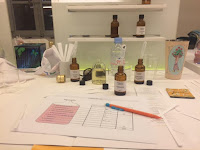So, what would be the experience of a Traditional Christmas in Provence for travellers meeting an authentic Provencal family ? The answer involves germinated wheat, 13 deserts, and small clay figures, called santons.
La Sainte Barbe
In Provence, Christmas Time (a period called Calendale) starts on Sainte-Barbe day (December 4th). People grow wheat grains in three different plates (the number three reprensenting the Holy Trinity) on moist cotton. If the wheat sprouts straight, the year will be successful. The germinated wheat will then ornate the Crèche and the Gros Souper table.
La Crèche
No Provencal Christmas would be complete without a Crèche, a representation with santons (ie. small saints), clay figures of the nativity scene. An ideal Crèche represents a Provençal village, with characters like the village fool, the miller, the sheperd and obviously Joseph, Mary and baby Jesus. There is even in Provence a village showing different crèches all around it!
Where to buy santons at traditional makers’, or on Christmas markets ?
The Cacho-Fio
Christmas Eve starts in Provence with the ceremony lighting of the Yule log, called cacho-fio. The fruit-tree log is splashed 3 times with mulled wine while the oldest of the family blesses it in the provençal language. Then the youngest of the family takes the log and turns arround the dinner table three times before putting it in the hearth. Once the log lit up, the Calendale Eve can start, with songs and cantics in Provecal, counts and music.
Also, people would go to shows mixing music and theatre called Pastorales.
Where to see a pastorale ?
The Gros Souper
While waiting for the Midnight Mass, Christmas Eve’s dinner is very important in Traditional Provence. The table is dressed with 3 white table clothes, one being smaller than the one before. There are three lit white candles next to the Sainte Barbe germinated wheat. Christmas roses, and holly are also decorating the table.
Christmas dinner is actually a lean meal, as Christmas Eve is still in the Advent Time. The Dinner would be made of season vegetables, snails with cardons, poivrade celery, artichokes, …
Provence is also famous for its 13 deserts : Hazelnuts, Dry figs, Almonds, Raisins, pompe à huile, white nougat, black nougat, dates, Aix calissons, Quince fruit paste, fresh white grapes, christmas melon, fresh oranges…
The number 13 is symbolic, representing Christ and his 12 apostles.
What about learning to cook with a local with Decouvertes and discover grocery stores?
The Midnight Mass
Some part of Provence perpetuate the tradition of the Pastrage Ceremony of the Winter Solstice. A pastor and children in traditional Provencal costumes roam the countrysiad and enter the church to the sound of galoubets and drums. A lamb is drawn in a small carriage decorated with ribbons, branches and candles and drawn by its mother. The lambi s thenpresented to the prior who takes it in his arms. The sheperd then tells his story to come and adorate baby Jesus.
Go watch the Pastrages in Les-Baux-de-Provence.
So, what would your perfect Provencal Christmas sound like ?


























